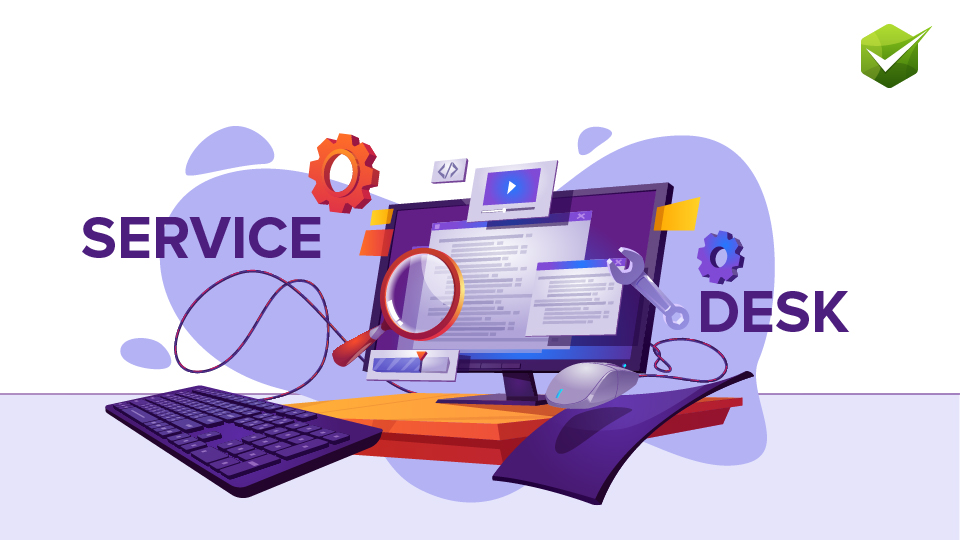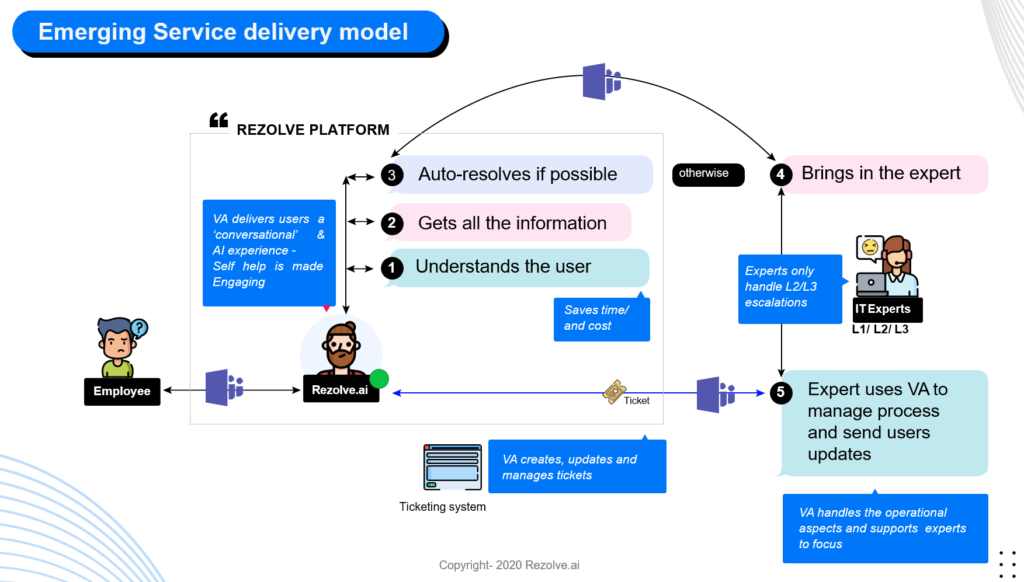
The new KPIs for AI/Chatbot powered Service Desk
by Manish Sharma, Co-Founder at Rezolve.ai
Service Desks have begun their journey towards an AI/Chatbot driven evolution. The allure of providing frictionless and quick service along with the promise of automation is attracting many Service Desk managers to look closely at this new emerging Service delivery model. According to the recent survey conducted by Rezolve.ai, 79% of the enterprises are planning to adopt an AI-driven Service Desk in 2021.
Will this new emerging AI-driven Service desk need new KPIs to be measured? Can we continue to use the existing KPIs that we are used to measuring or are we about to invest/discover different KPIs to keep up with the new Service Desk? To discuss this – let us review the key differences between traditional and emerging service delivery models.
Traditional Service delivery model:
The traditional service delivery model typically depends on phones and emails as channels for getting the issue information to the Service Desk. Ticket creation by employees is a distant third in terms of issue reporting. The typical challenges with this model are:
- Wait or hold time at phone sometime leading to abandoned calls
- Incomplete information within the ticket leading to back and forth between L1 and employee
- Rerouting ticket to L2/L3 with a possibility of another back and forth with employee
All follow-ups/confirmations are typically done over the phone or by email.
Traditional Service Desk KPIs:
Although there are a lot of KPIs used by different organizations – we found that these 8 KPIs were universally acknowledged to be effective in measuring the performance of a Service Desk. These are:
- CSAT (Customer Satisfaction)
- Agent Utilization
- First Contact Resolution Rate
- First Level Resolution Rate
- Agent Satisfaction
- Aggregate Service Desk Performance
- MTTR (Mean Time to Resolve)
Emerging Service Delivery model:
The advent of modern service desks or emerging service delivery models can be attributed to two leading causes:
1. Maturing and all-pervading Artificial Intelligence technology
2. Ascendance and wide-spread use of collaboration tools like MS Teams, Slack, etc.
Modern Service Desks like Rezolve.ai are not providing incremental improvement to or tweaking the traditional service delivery model – but rather are rewriting the fundamentals on how employees should get support in the 21st century.
Read about- 20 key benefits of automation systems in the Service Desk Industry
Let us look at what an emerging service delivery model looks like:

The employee support is now primarily provided via a collaboration tool (MS Teams, Slack, etc.) and is front-ended by an AI platform or chatbot. When an employee needs help, he/she reaches out to the AI platform integrated within its collaboration tool.
The AI platform interacts with the employee conversationally and understand the issue and get all related information. It then attempts to resolve the issue right away by either providing the right information or carrying out a simple task for the employee.
This “auto-resolution” typically takes 10 to 15 seconds – and the tickets are created and updated by the AI platform on the employee’s behalf. However, if the initial triaging does not help – the AI platform will escalate the issue to an L2/L3 agent and perhaps bring them into a live real-time chat with the employee to address the issue. It might also create an issue and assign it to L1 if it failed to understand the issue.
Typically, a lot of automation can be built-in within the AI platform to improve the instantaneous “auto-resolution” rate – and the users do not have to use older channels like phones and emails – as they find the AI platform much quicker and simple to use.
Due to many differences from the traditional service delivery model – it is important to track the right Key Performance Indicators (KPIs) to measure the performance of a modern Service Desk. There are three categories of KPIs suggested for the modern Service Desk as described below.
Read about- How Can a Service Desk be Managed Within Microsoft Teams?
Evergreen KPIs:
These KPIs are the same KPIs that we always measured – and are relevant today for an AI–driven Service Desk as well. These are:
- CSAT
- MTTR (Mean Time to Resolve)
- Agent job satisfaction
Refreshed KPIs:
These KPIs are the ones that are getting upgraded in the context of an AI-driven service desk
1. Cost per contact replaced with Cost per ticket: Traditional Service Desks were very reliant on human-to-human interaction for resolving the majority of the issues. And therefore, measuring the cost of each interaction was very important. However, a modern service desk “auto-resolves” the majority of the repetitive issues, and only in case of complex issues a “human-to-human” touch is needed. Therefore, measuring “cost per contact” does not give a complete picture or great inference on the efficiency of agents. A great alternative to measure is “Cost per ticket” – an all-encompassing metric that allows managers to monitor the overall efficiency of their service desks. This KPI can be further broken into “Cost per L1 ticket”, “cost per L2 ticket” etc.
2. Agent Utilization replaced with Number of tickets per agent: Agent utilization is typically measured by the number of inbound and outbound contacts handled by an agent divided by the unit of time. Since a good measure of the L1 agent’s task was “handling contacts” – this was a good proxy for the agent’s productivity. However, this was the proxy for “effort” and not “outcome/output”. Given the changing nature of an agent’s work due to AI – the more relevant KPI that we recommend is “Number of tickets per agent”. Typically, this can be calculated by dividing the number of tickets resolved by the agent per unit of time.
New KPIS
1. Accuracy of AI: Given that the primary service delivery channel now is an AI platform or chatbot – it is important to measure the accuracy of the system. What percentage of the time users get the intended response and how many times the AI is not able to understand? Obviously, you want this metric to improve and eventually be in the 90s for your platform.
2. Escalation to humans: A good AI system should have the ability to bring a human agent into the conversation if it cannot help the employees. What percentage of the time did the AI platform have to do that? You want this percentage to go down over a period of time.
3. New automation skills created: Automation is an integral part of a modern Service Desk. For example, in the case of Rezolve.ai, you could add “Knowledge”, “Task” or “process” skills on an ongoing basis. This needs to be measured every month in order to keep up the “automation quotient” for your service desk.
Dropped KPIs:
As many would have noticed, some KPIs did not make it from the traditional set to the new one. Notable among those are First Contact Resolution Rate and First Level Resolution Rate. Although they are very critical in the traditional Service Desk, in the modern Service Desk, “auto-resolution” without contact is default behavior. Therefore, these KPIs make less sense to carry on.
Rezolve.ai- A Modern AI–Based Service Desk
If you would like to know more about our MS teams centric AI driven service desk (Rezolve.ai), please reach out to us here or attend our webinars.
About the author

As co-founder of Rezolve.ai Manish Sharma is focused on bringing AI driven innovation to the Service Desk and helping enterprises to achieve their Service Desk automation targets. Manish says “disruption driven by AI and other digital technologies… will transform our businesses and lives beyond our imagination in next 24-36 months. I am here to help organizations and businesses understand and leverage these new technologies to their advantage.”























